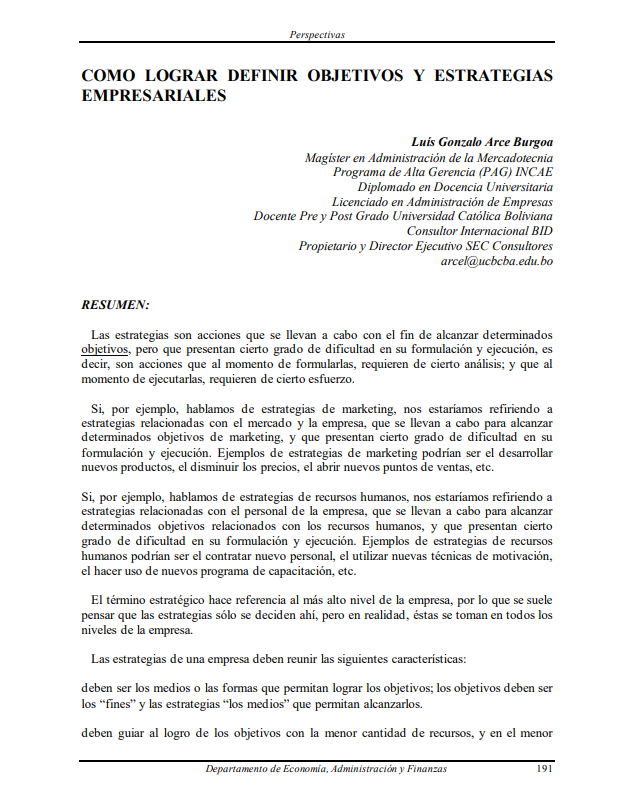How to successfully define business objectives and strategies
DOI:
https://doi.org/10.35319/p649dg09Keywords:
Business strategy, Organizational objectives, Human resourcesAbstract
Strategies are actions designed to achieve specific goals and involve analysis during planning and effort during execution. They apply to various areas, such as marketing or human resources, and are not limited to top management decisions—they occur at all levels of the company. Strategies must serve as clear and efficient means to reach objectives using minimal resources and time. They should align with company values, pose a challenge, and be feasible within a reasonable timeframe. Additionally, strategies help take advantage of opportunities, counter external threats, strengthen internal strengths, or overcome weaknesses.
Downloads
References
FRED R. David (2003). Conceptos de Administración Estratégica, novena edición, Ed. Pearson. México D.F.
IVANCEVICH, John M. (1997). Gestión Calidad y Competitividad. Ed. McGraw-Hill. España.
ANSOFF, I.H. "Synergies and capabilities profile". New Corporate Strategy. 1988.
CHARTTERJEE, S. “Gains in vertical acquisitions and market power: theory and evidence”. Academy of Management Journal, Vol. 34 (3), pp. 718-733. 1991.
D'AVENI, R.; RAVENSCRAFT, D. “Economies of integration versus bureaucracy costs: Does vertical integration improve performance?”. Academy of Management Journal, vol. 37 (5), pp. 1167-1206. 1994.
DEMSETZ, H. "The theory of the firm revisited". Journal of Law, Economics and Organization, vol. 1, pp. 141-161. 1988.
HAMEL, G. y PRAHALAD, C. K. Competing for the Future. Cambridge, Mass.: Harvard Business School Press, 1994, p. 227.
KAPLAN, R. y KAPLAN, D. (2004). Mapas Estratégicos, primera edición. Ed. Editorial 2000. España.
THOMPSON Jr., A.A. y STRICKLAND III, A.J. (2003). Administración Estratégica, 13ª edición. Ed. McGraw-Hill. México D.F.
BATEMAN, Thomas y SNELL, Scout (1999). Administración, una ventaja competitiva, cuarta edición. Ed. McGraw-Hill. México.
ZEVALLOS, Emilio y VELAZCO, Enrique (2003). Construyendo el Desarrollo a través de las PYMES – La experiencia Boliviana. Ed. Fundes Internacional. Bolivia.
SOTO PINEDA, Eduardo (2004). Las PYMES ante el retorno del siglo XXI: los nuevos mercados globales, primera edición. Ed. Thomson. México.
Guías de Gestión de la Pequeña Empresa. La Ventaja Competitiva. Ed. Díaz de Santos, S.A. (1997). España.
HERMIDA, Jorge; SERRA, Roberto; KATIKA, Eduardo (1998). Administración y Estrategia: Un Enfoque Competitivo y Emprendedor, primera edición. Ed. Macchi. Argentina.
HERMIDA, Jorge y SERRA, Roberto (2001). Administración y Estrategia, segunda edición. Ed. Macchi. Argentina.
THOMPSON, Arthur A. y STRICKLAND, A.J. (2001). Administración Estratégica: Conceptos y casos, 11ª edición. Ed. McGraw-Hill. México.

Downloads
Published
Issue
Section
License
Copyright (c) 2010 Revista Perspectivas

This work is licensed under a Creative Commons Attribution-NonCommercial-ShareAlike 4.0 International License.
La Revista Perspectivas de la Universidad Católica Boliviana, es una revista de acceso abierto, por lo tanto, es de libre acceso en su integridad. Está permitida su lectura, búsqueda, descarga, distribución y reutilización legal en cualquier tipo de soporte únicamente para fines no comerciales, siempre y cuando la obra sea debidamente citada.




